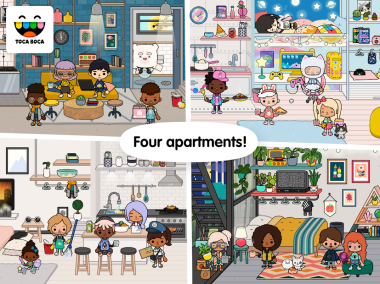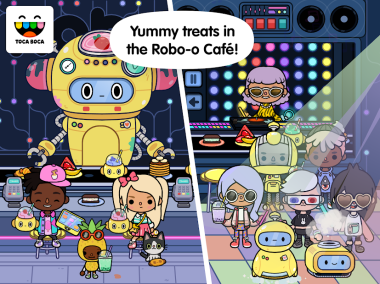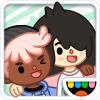Toca Life: Neighborhood Review
If you’re familiar with the Toca Boca universe, you already know that their “Life” series consistently crafts imaginative digital playgrounds where creativity and exploration have no bounds. Toca Life: Neighborhood continues this trend, delivering an unstructured, open-ended experience that’s as flexible as the virtual city blocks it introduces. But is it as engaging for returning players as it is for newcomers? As an experienced gamer with a keen eye for what makes a sandbox game stand out, I dove in to find out how the latest entry holds up, especially considering its popularity on search platforms looking for free downloads, mods, and even unblocked versions for every possible device.
First Impressions – Color, Charm, and Instant Accessibility
Upon starting Toca Life: Neighborhood, it’s immediately clear that the game aims to capture a vibrant, inclusive vision of modern city life. Graphically, it eschews the glossy, high-resolution trends of many modern games in favor of a hand-drawn aesthetic bursting with detail and color. Every shop, building, and character reflects this warm, approachable art style. It’s not only visually pleasing for younger players but also charms adult fans (including this reviewer) who appreciate a break from photorealistic complexity. At launch, Toca Life: Neighborhood can be accessed through the Apple App Store, Google Play, and Amazon; there’s no official PC or console build, though some players use emulation for desktop access.
Core Gameplay – A Narrative You Construct
No levels. No victory conditions. No in-game currency. Instead, Toca Life: Neighborhood invites you to simply play, experiment, and tell your own stories. The small neighborhood hub is split into four main locations: a bustling apartment complex, a quirky street filled with shops and eateries, a selfie studio, and a moving truck that serves as the gateway to changing inhabitants and setups. The open-ended structure means that the “objective” is left wholly up to the player’s imagination—move furniture, set up apartments, create elaborate meals, or stage silly, heartfelt, or just plain weird social encounters.
The drag-and-drop controls are intuitive enough for the youngest players but aren’t patronizing or watered down. For experienced sandbox fans, the game’s true appeal is discovering small environmental secrets and taking advantage of the nearly boundless interactions—if you can see it, you can probably pick it up, place it somewhere strange, or hand it to a character.
Creativity Unleashed: Customization and Play Patterns
Customization is at the heart of the Toca formula, and Neighborhood may offer the most extensive options yet. Players can design residents, personalize apartments, and shift objects around at will. The variety is also amplified by the sheer number of interactable items, adding unexpected humor to even the most mundane activities. Want to throw a plant in the laundry, or rearrange the pizza toppings at the downtown café? Go for it. There are no limits—and no consequences—making the game an ideal vehicle for free-form creative expression.
While many will play solo, there’s a surprising social aspect. Kids can work together on the same device to invent stories or act out scenarios, and some resourceful players even share their collaborative creations on social platforms. Mods and cheats aren’t officially supported, but third-party apps do try to capitalize on their popularity, offering bonus items or cosmetic tweaks. Caution is recommended if you go this route.
Progression, Rewards, and Lasting Power
Without traditional leveling or scorekeeping, Toca Life: Neighborhood leans heavily on intrinsic motivation. For the target audience, this lack of competitive structure is a feature, not a flaw. The rewards are the funny, heartwarming, or just plain odd stories that emerge naturally from free play. Still, older or more goal-oriented users might find the sandbox loop repetitive after a while, especially if they’ve exhausted most of the environmental secrets or want to see more in-game events and crossover content with other Toca titles.
Accessibility, Platforms, and Unblocked Play
True to Toca Boca’s commitment to accessibility for families, installation is quick and the game runs smoothly even on older mobile devices. The game isn’t free to play—you’ll need to purchase and install Toca Life: Neighborhood via iOS or Android. However, because of its popularity, searches for free or unblocked versions persist, particularly among players looking to circumvent school or office content restrictions. Officially, there’s no legitimate way to play the game free or unblocked outside authorized app stores. As for cheats, in-app secrets (think hidden items and characters) provide their own form of in-game discovery, but altering gameplay itself isn’t supported.
Worth noting is the lack of any in-app advertisements or microtransactions once you’ve downloaded and installed the game, a breath of fresh air in a market often overwhelmed with monetization tactics. This makes Toca Life: Neighborhood a safer and more relaxing space for families concerned about ad exposure.
Conclusion – A Joyful Sandbox (With a Few Limitations)
Toca Life: Neighborhood is one of the purest incarnations of digital sandbox play, encouraging curiosity, inclusivity, and collaboration. While its appeal is clearly positioned for children, there’s plenty of fun, subtle humor, and creativity for players of all ages. The lack of free, unblocked, or modded versions means you’re largely locked into the official, well-crafted experience—which, in the case of Toca Boca, is rarely a bad thing. For anyone seeking a different pace from the usual competitive mobile fare, or for families looking to install a worry-free playground on their devices, this is an easy recommendation.
How to download Toca Life: Neighborhood
Toca Life: Neighborhood is available as a paid app on iOS (App Store), Android (Google Play), and Amazon. The game isn’t free, so you’ll need to purchase it through these official storefronts; there’s no version for PC, Windows, Mac, or consoles, though you may run the Android app using emulators.
To install, simply find the game in your chosen app store, purchase, and download directly to your device. Minimum system requirements are modest, with most modern Android devices (4.4+), iPhones (iOS 10+), and basic tablets able to run the game smoothly.
There are no official mods or cheats available; third-party mods are unsupported and could be insecure. Unblocked access isn’t officially provided, so players in restricted environments should stick to official download platforms.
Screenshots






Leave a comment
Your comment is awaiting moderation. We save your draft here
0 Comments